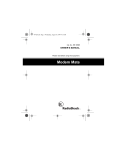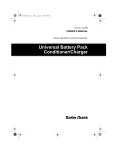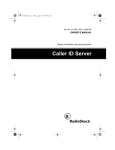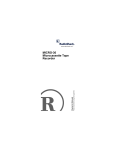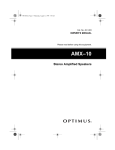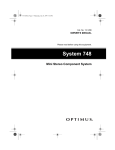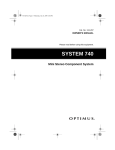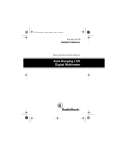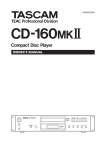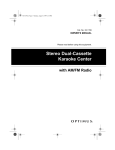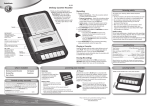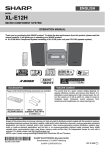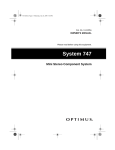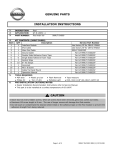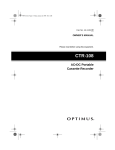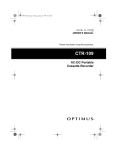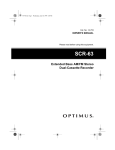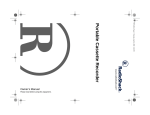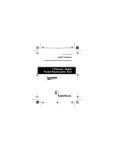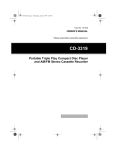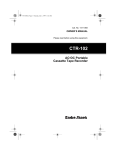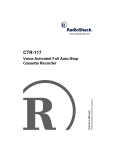Download Optimus 739 Home Theater System User Manual
Transcript
13-1292.fm Page 1 Wednesday, July 14, 1999 6:37 PM Cat. No. 13-1292 OWNER’S MANUAL Please read before using this equipment. SYSTEM 739 Mini Stereo Component System 13-1292.fm Page 2 Wednesday, July 14, 1999 6:37 PM FEATURES Your Optimus System 739 Mini Stereo Component System includes an AM/ FM tuner, a cassette player, a CD player, and matching speakers. It delivers great sound, and because of its small size, it is perfect for a bedroom, the kitchen, or even the office. You can listen to your favorite CDs, and the cassette deck lets you record from a CD or the radio. E-Bass — provides richer, fuller bass sound. Automatic Level Control — automatically adjusts the recording level. Note: CDs that can be played on this player have this mark on them: Its features include: Automatic Skip Music System — lets you quickly find any track on a CD. Programmed Play — lets you program up to 21 tracks on a CD to play in any order you choose. Repeat Play — repeats the current track, the entire CD, or a programmed sequence. 5- or 3-Inch CD Compatible æ lets you play 5- or 3-inch CDs. Auto-Stop — automatically stops the cassette tape when it reaches the end. Fast-Forward and Rewind — let you quickly find a section on a cassette tape. Note: Most material on compact discs and prerecorded tapes is copyrighted. Unauthorized duplication of copyrighted material is a violation of the copyright laws of many countries and such duplication may result in fines and/or imprisonment. Note, however, that in the United States, it is not a violation of U.S. copyright laws for a consumer to use an audio recording device to duplicate musical recordings for noncommercial (personal) use. Read this manual carefully. It will help you get the most enjoyment from your system. We suggest you write your music system’s serial number here. The number is on the back of the system. Serial Number: ________________ © 1996 Tandy Corporation. All Rights Reserved. Optimus is a registered trademark used by Tandy Corporation. RadioShack is a trademark used by Tandy Corporation. 2 13-1292.fm Page 3 Wednesday, July 14, 1999 6:37 PM FCC INFORMATION This system complies with the limits for a Class B digital device as specified in Part 15 of FCC Rules. These limits provide reasonable protection against radio or TV interference in a residential area. However, your system might cause TV or radio interference even when it is operating properly. To eliminate interference, you can try one or more of the following corrective measures: Warning: To prevent fire or shock hazard, do not expose this product to rain or moisture. CAUTION RISK OF ELECTRIC SHOCK. DO NOT OPEN. CAUTION: TO REDUCE THE RISK OF ELECTRIC SHOCK, DO NOT REMOVE COVER OR BACK. NO USER-SERVICEABLE PARTS INSIDE. REFER SERVICING TO QUALIFIED PERSONNEL. • Reorient or relocate the receiving antenna. This symbol is intended to alert you to the presence of uninsulated dangerous voltage within the product’s enclosure that might be of sufficient magnitude to constitute a risk of electric shock. Do not open the product’s case. • Increase the distance between the system and the radio or TV. • Use outlets on different electrical circuits for the system and the radio or TV. Contact your local RadioShack store if the problem still exists. Warning: This system employs a laser light beam. Only a qualified service person should remove the cover or attempt to service this device, due to possible eye injury. ! ! This symbol is intended to inform you that important operating and maintenance instructions are included in the literature accompanying this product. . 3 13-1292.fm Page 4 Wednesday, July 14, 1999 6:37 PM CONTENTS Preparation ........................................................................................................... 5 Connecting the Speakers ................................................................................ 5 Connecting an External Antenna ..................................................................... 5 Connecting to Power ....................................................................................... 5 Using Headphones .......................................................................................... 6 Listening Safely ......................................................................................... 6 Using the Radio .................................................................................................... 7 Using the CD Player ............................................................................................. 8 Playing a CD .................................................................................................... 8 Automatic Skip Music System ......................................................................... 9 Repeat Play ................................................................................................... 10 Programmed Play .......................................................................................... 10 Checking a Programmed Sequence ....................................................... 11 Replacing a Track in a Programmed Sequence ..................................... 11 Clearing a Programmed Sequence ......................................................... 11 Using the Cassette Deck ................................................................................... 12 Playing a Cassette Tape ................................................................................ 12 Recording ...................................................................................................... 13 Care and Maintenance ....................................................................................... CD Care Tips ................................................................................................. Tape Tips ....................................................................................................... Erasing a Cassette Tape ......................................................................... Preventing Accidental Erasure ................................................................ Cleaning the Tape-Handling Parts ................................................................. Restoring Tape Tension and Sound Quality .................................................. 14 15 15 15 15 16 17 Specifications ..................................................................................................... 18 4 13-1292.fm Page 5 Wednesday, July 14, 1999 6:37 PM PREPARATION Note: Complete all other connections before connecting your music system to a standard AC outlet. system. Follow the instructions supplied with the antenna to connect it. CONNECTING THE SPEAKERS 1. Press the red and black terminal tabs marked R on the back of the system, then insert the right speaker’s solid red wire into the red (+) terminal and its black/red striped wire into the black (–) terminal. Then release the tabs to close the terminals. 2. Repeat Step 1 to connect the left speaker’s wires to the terminals marked L . CONNECTING AN EXTERNAL ANTENNA Note: If you have an outside VHF TV antenna, you can use a 300-ohm signal splitter to connect your music system and TV set to the same antenna. Your local RadioShack store sells antennas and connectors that enable you to make this connection. CONNECTING TO POWER After you connect the speakers and an external antenna (if desired), plug the music system’s power cord into a standard AC outlet. Caution: The supplied AC power cord has a polarized plug that fits into the outlet only one way. If the plug does not fit properly, turn it over and try again. Do not force it. The system has two antennas. The AM antenna is built-in and the power cord acts as the FM antenna. For improved reception, you can attach an external FM or VHF antenna (not supplied) to the 75-ohm or 300-ohm terminals on the back of the music 5 13-1292.fm Page 6 Wednesday, July 14, 1999 6:37 PM USING HEADPHONES Listening Safely You can use headphones (not supplied) to listen in privacy. Insert the headphones’ 1/8-inch plug into the PHONES jack on the front of the system. To protect your hearing, follow these guidelines when you use headphones. • Set the volume to the lowest setting before you begin listening. After you begin listening, adjust the volume to a comfortable level. • Do not listen at extremely high volume levels. Extended highvolume listening can lead to permanent hearing loss. Notes: • Your local RadioShack store sells a wide selection of headphones. • Plugging in headphones automatically disconnects the speakers. 6 • Once you set the volume, do not increase it. Over time, your ears adapt to the volume level, so a volume level that does not cause discomfort might still damage your hearing. 13-1292.fm Page 7 Wednesday, July 14, 1999 6:37 PM USING THE RADIO Note: To protect your hearing, set the volume to its lowest setting before you turn on the radio. 1. Press POWER to turn on the system. The POWER indicator lights. Notes: • For the best AM reception, rotate the system. • For the best FM reception, uncoil the power cord and extend it to its full length. • If FM reception is strong, set BAND to FM STEREO. The FM STEREO indicator lights when you receive an FM broadcast in stereo. 2. Set FUNCTION to TUNER. 3. Set BAND to AM or one of the FM settings. • If FM reception is weak, set BAND to FM MONO. The FM STEREO indicator turns off and the sound is monaural, but the reception should improve. 5. Rotate VOLUME to a comfortable level. 6. Set E-BASS to ON for enhanced bass sound. Set E-BASS to OFF for normal bass sound. 4. Rotate TUNING to receive the desired station. 7. Press POWER to turn off the system. The POWER indicator turns off. 7 13-1292.fm Page 8 Wednesday, July 14, 1999 6:37 PM USING THE CD PLAYER PLAYING A CD Note: To protect your hearing, set the volume to its lowest setting before you begin playing a CD. 1. Press POWER to turn on the system. The POWER indicator lights. 2. Set FUNCTION to CD. 00 appears briefly, then dISC appears on the display. 3. Press CLOSE/ OPEN to open the CD compartment. OPEN appears on the display. 4. With the label side up, carefully place the CD’s hole over the center hub. 8 5. To close the CD compartment door, press down gently on the right corner of the CD compartment door until the door clicks shut. 00 appears on the display for a few seconds, then the display shows the total number of tracks and the CD’s total playing time. 6. Press PLAY/PAUSE to play all the tracks in order starting with Track 1. , the current track number, and the current track’s elapsed time appear on the display. Note: Press PLAY/PAUSE to stop the CD temporarily. II appears on the display. Press PLAY/PAUSE again to resume playing the CD. 13-1292.fm Page 9 Wednesday, July 14, 1999 6:37 PM 7. Adjust VOLUME and E-BASS for the desired sound. 11. When you finish listening, press POWER to turn off the system. The POWER indicator turns off. AUTOMATIC SKIP MUSIC SYSTEM 8. Press STOP to stop playing the CD before all tracks have played. The total number of tracks and the CD’s total playing time appear on the display. The automatic skip music system (ASMS) lets you quickly locate the beginning of any track on the CD, including the track currently playing. You can use ASMS when the CD is playing or is stopped. If the CD is playing: 9. Press CLOSE/ OPEN to open the CD compartment and remove the CD. OPEN appears on the display. • Press SKIP to return to the beginning of the current track. to skip to the • Press SKIP beginning of the next track. • Repeatedly press SKIP to skip backward or through tracks. Note: Do not remove the CD until after it stops turning. or forward The selected track begins to play automatically. 10. Close the CD compartment. 00, then dISC appears on the display. 9 13-1292.fm Page 10 Wednesday, July 14, 1999 6:37 PM If the CD is stopped, repeatedly press SKIP or until the display shows the number of the track you want to play, then press PLAY/PAUSE. The CD player starts playing the selected track. To repeat the entire CD, press REPEAT twice during play. REPEAT ALL appears on the display. The CD player continuously replays the entire CD. Note: At the beginning of a CD, you can only skip forward. At the end of a CD, you can only skip backward. REPEAT PLAY You can repeat the current track, the entire CD, or a programmed sequence. To repeat the current track, press REPEAT once during play. REPEAT 1 appears on the display. The CD player continuously replays the current track. If a programmed sequence is stored in memory (see “Programmed Play”), pressing REPEAT twice continuously replays the programmed sequence instead of the CD tracks in order. To cancel any repeat function, press REPEAT until REPEAT disappears from the display. PROGRAMMED PLAY You can program up to 21 tracks on a CD to play in any sequence you choose. Note: You cannot program tracks while a CD is playing. 1. Press POWER to turn on the system. The POWER indicator lights. 10 13-1292.fm Page 11 Wednesday, July 14, 1999 6:37 PM 2. Press PROGRAM on the CD player. 00 P :01 MEMORY appears on the display. During play, you can press SKIP or to move through the programmed tracks. The track plays automatically and the display shows the current track. Checking a Programmed Sequence or to select 3. Press SKIP the track you want to store in the first memory location. 4. Press PROGRAM. That track is stored in location 01, and 00 P :02 MEMORY appears on the display. 5. Repeat Steps 3 and 4 to program up to 21 tracks. Note: If you try to program more than 21 tracks, you will replace the first tracks with new tracks. While a CD is stopped, repeatedly press PROGRAM to move through the programmed sequence. Replacing a Track in a Programmed Sequence While a CD is stopped, repeatedly press PROGRAM until the track you want to replace appears on the display. Then press SKIP or until the new track appears on the display. Press PROGRAM. Clearing a Programmed Sequence To clear the programmed sequence, press CLOSE/ OPEN. 6. Press PLAY/PAUSE. The CD player plays the tracks in the programmed order. , the current track number, the track’s elapsed time, and PROGRAM appear on the display. 11 13-1292.fm Page 12 Wednesday, July 14, 1999 6:37 PM USING THE CASSETTE DECK PLAYING A CASSETTE TAPE 5. Close the cassette compartment door. 6. Press PLAY on the cassette deck. Note: To protect your hearing, set the volume to its lowest setting before you begin playing a cassette tape. 1. Press POWER to turn on the system. The POWER indicator lights. 2. Set FUNCTION to TAPE. The cassette tape automatically stops when it reaches the end. Notes: • To temporarily stop play, press PAUSE. Press PAUSE again to resume play. 3. Press STOP/EJECT on the tape deck to open the cassette compartment door. • To rapidly wind the tape forward or backward, press FAST-F. or REWIND. The cassette deck automatically stops at the end of the tape. 7. Adjust VOLUME and E-BASS for the desired sound. 4. Load the cassette in the compartment with the open end down, the full reel on the left, and the side you want to play facing you. 8. To manually stop play, press STOP/EJECT. Press STOP/EJECT again to open the cassette compartment. 12 13-1292.fm Page 13 Wednesday, July 14, 1999 6:37 PM RECORDING 1. Press POWER to turn on the system. You can record from the CD player or radio. 2. Set FUNCTION to TUNER to record from the radio or to CD to record from a CD. Notes: • Tape quality greatly affects the quality of the recording. For lownoise, wide range recordings, use normal-bias tape. We recommend regular length (60 or 90minute) cassette tapes. We do not recommend long-play cassette tapes, such as C-120s, because they are thin and can tangle easily. • Before you load a cassette tape for recording, turn the cassette’s hub with your finger or a pencil to move the tape past its leader. • The system’s Automatic Level Control (ALC) automatically adjusts the recording level. VOLUME and E-BASS have no effect on recording. Caution: If you try to record on a cassette tape that has had the erase-protection tabs removed, you cannot press RECORD. Do not force it, as this can damage the mechanism. See “Preventing Accidental Erasure” on Page 15. 3. Insert a tape into the cassette compartment and press PAUSE. 4. Press RECORD. The PLAY button automatically locks down. The RECORD indicator lights. 5. Tune the radio to the desired station or start the CD. Then release PAUSE. Recording begins. Note: You might hear a lowvolume tone from the system’s speakers during playback after you record from AM radio. If you hear the tone, set E-BASS to ON the next time you record. This turns on the AM beat cut circuit, which helps eliminate such tones. 13 13-1292.fm Page 14 Wednesday, July 14, 1999 6:37 PM CARE AND MAINTENANCE Your System 739 Mini Stereo Component System is an example of superior design and craftsmanship. The following suggestions will help you care for your music system so you can enjoy it for years. Keep the music system dry. If it gets wet, wipe it dry immediately. Liquids might contain minerals that can corrode the electronic circuits. Use and store the music system only in normal temperature environments. Temperature extremes can shorten the life of electronic devices and distort or melt plastic parts. Keep the music system away from dust and dirt, which can cause premature wear of parts. Handle the music system gently and carefully. Dropping it can damage circuit boards and cases and can cause the music system to work improperly. Use only fresh batteries of the required size and type. Old batteries can leak chemicals that damage your music system’s electronic parts. CLEANER Wipe the music system with a damp cloth occasionally to keep it looking new. Do not use harsh chemicals, cleaning solvents, or strong detergents to clean the music system. Modifying or tampering with the music system’s internal components can cause a malfunction and might invalidate your music system’s warranty and void your FCC authorization to operate it. If your music system is not performing as it should, take it to your local RadioShack store for assistance. 14 13-1292.fm Page 15 Wednesday, July 14, 1999 6:37 PM CD CARE TIPS Even though a compact disc is very durable, treat the CD surface with care. We recommend the following precautions: • Do not write on either side of the CD, particularly the non-label side (signals are read from the nonlabel side). • Do not store CDs in high temperature, high-humidity locations. They might warp. • Keep CDs dry. A water drop can act as a lens and affect the laser beam’s focus. • Always handle a CD by the edges to avoid fingerprints and always keep it in its protective case or sleeve when it is not in use. Fingerprints and scratches on the CD’s surface can prevent the laser beam from correctly reading the digital information. If the CD gets scratched, use Scratch ’n Fix (RadioShack Cat. No. 42-127) to keep the disc from skipping. TAPE TIPS Erasing a Cassette Tape If you no longer want a recording, you can record over it or erase it. To erase a previously recorded section of a tape, simply record over it. To erase the entire cassette tape, let the tape record to the end. You can quickly erase both sides of a cassette tape using a bulk tape eraser (such as Cat. No. 44-232, not supplied), available at your local RadioShack store. Preventing Accidental Erasure Cassette tapes have two eraseprotection tabs — one for each side. To protect a recording from being accidentally recorded over or erased, use a screwdriver to remove one or both of the cassette tape’s eraseprotection tabs. . 15 13-1292.fm Page 16 Wednesday, July 14, 1999 6:37 PM If you want to record on a tape after you have removed the eraseprotection tab for that side, place a piece of strong plastic tape over that side’s erase-protection hole. Be sure you cover only the portion originally covered by the erase-protection tab. Note: Removing the erase-protection tabs does not prevent a bulk eraser from erasing a cassette tape. CLEANING THE TAPEHANDLING PARTS Dirt, dust or particles of the tape’s coating can accumulate on the tape heads and other parts that the tape touches. This can greatly reduce the performance of the cassette player. Use the following cleaning procedure after every 20 hours of tape player operation. 1. Disconnect the power cord. 2. Open the cassette compartment door. 16 3. Press PLAY to expose the tapehandling parts. 4. Use a cotton swab dipped in denatured alcohol or tape head cleaning solution to clean the record/play head, pinch roller, capstan, tape guides, and erase head. 5. When you finish cleaning, press STOP/EJECT and close the cassette compartment door. Then reconnect power. Your local RadioShack store sells a wide selection of tape head-cleaning supplies. 13-1292.fm Page 17 Wednesday, July 14, 1999 6:37 PM RESTORING TAPE TENSION AND SOUND QUALITY After you play a cassette tape several times, the tape might become tightly wound on the reels. This can cause playback sound quality to deteriorate. To restore the sound quality, fastforward the tape from the beginning to the end of one side, then completely rewind it. Then loosen the tape reels by gently tapping each side of the cassette’s outer shell on a flat surface. Caution: Be careful not to damage the cassette when tapping it. Do not touch the exposed tape or allow any sharp objects near the cassette. 17 13-1292.fm Page 18 Wednesday, July 14, 1999 6:37 PM SPECIFICATIONS Radio Tuning Range ............................................................................ AM: 530–1710 kHz FM: 88–108 MHz Cassette Tape Speed ............................................................................................ 4.8 cm/sec Wow and Flutter ................................................................................ 0.35% WRMS Frequency Response (at ±3 dB) ........................................................ 125 Hz–8 kHz Recording System ....................................................................................... AC Bias Erase System ............................................................................................... Magnet CD Player Number of Tracks to be Programmed ...................................................... 21 Tracks Frequency Response (at ±3 dB) ....................................................... 80 Hz–12 kHz Dynamic Range ............................................................................................. 83 dB Signal-to-Noise (JIS-A) .................................................................................. 64 dB Harmonic Distortion (at 1 kHz) ........................................................................ 0.8% Separation (at 1 kHz) ...................................................................................... 60 dB Sampling Frequency ................................................................................. 44.1 kHz Quantization Number .............................................................16-Bit Linear/Channel Oversampling .............................................................................................. 2 Times Pick-Up System .......................................................................................... 3 Beam Optical Source ....................................................................... Semiconductor Laser Wavelength ...................................................................................................790 nm 18 13-1292.fm Page 19 Wednesday, July 14, 1999 6:37 PM General Power Supply ........................................................................ 120V AC, 60 Hz, 10W Speaker Size .............................................................................................. 4 Inches Speaker Impedance .................................................................................... 8 Ohms Power Output (10% THD) .................................................... 1.5 Watts per Channel Dimensions (HWD, Including Speakers) .......................... 91/16 × 171/8 × 79/16 Inches (230 × 435 × 192 mm) Weight ............................................................................................................ 5.5 lb (2.5 kg) Specifications are typical; individual units might vary. Specifications are subject to change and improvement without notice. 19 13-1292.fm Page 20 Wednesday, July 14, 1999 6:37 PM RadioShack Limited Warranty This product is warranted against defects for 90 days from date of purchase from RadioShack company-owned stores and authorized RadioShack franchisees and dealers. Within this period, we will repair it without charge for parts and labor. Simply bring your RadioShack sales slip as proof of purchase date to any RadioShack store. Warranty does not cover transportation costs. Nor does it cover a product subjected to misuse or accidental damage. EXCEPT AS PROVIDED HEREIN, RadioShack MAKES NO EXPRESS WARRANTIES AND ANY IMPLIED WARRANTIES ARE LIMITED IN DURATION TO THE DURATION OF THE WRITTEN LIMITED WARRANTIES CONTAINED HEREIN. Some states do not permit limitation or exclusion of implied warranties; therefore, the aforesaid limitation(s) or exclusion(s) may not apply to the purchaser. This warranty gives you specific legal rights and you may also have other rights which vary from state to state. We Service What We Sell 10/95 RadioShack A Division of Tandy Corporation Fort Worth, Texas 76102 8A6 Printed in Hong Kong




















